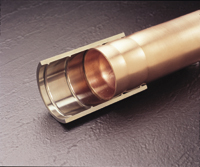

Our couplings are based on Shape Memory Metal technology using
Tinel, a nickel and titanium-based alloy. When Tinel is exposed below a specific
temperature, it can be mechanically deformed. However, when the temperature
is raised, Tinel returns to its predetermined shape. This shape change occurs
at a unique transformation temperature determined by the alloy composition.
We've discovered that the cycle can be successfully repeated with consistent
results. The Tinel alloy's composition allows for control of such properties
as transformation temperature, yield strength, and consistent recovery stress.
There are Two Sides to Every Crystalline Structure .
Tinel exists in one of two stable crystalline phases: a high-temperature
phase called austenite, and a low-temperature phase called martensite. In
the austenitic phase, the crystalline structure is body-centered cubic. When
cooled below its transformation temperature, the austenitic structure undergoes
a diffusionless shear transformation to a highly-twinned martensite crystal
structure.
In this martensitic phase, the twinned structure can be mechanically
deformed to a parallel registry. This deformation of approximately eight percent
remains as long as Tinel is below its transformation temperature. However,
when the deformed martensitic structure warms through its transformation temperature,
it returns immediately to the aystensitic form. Left unrestricted, the Tinel
will return to its original shape.
Our SMARTFIT® Couplings are Chilled to Perfection.
Made from Tinel, the SMARTFIT® coupling - or sleeve - is machined at room
temperature, in its high strength (austenitic) state, to an inside diameter
slightly smaller than the pipes or tubes it is to join. The component is then
cooled in liquid nitrogen and the metallurgical characteristics of the alloy
change to the lower strength (martensitic) state. With the coupling in this
lower strength, cooled state, a tapered mandrel is driven through its center,
expanding the inside diameter of the coupling. The coupling remains in cold
storage in its expanded condition until ready for use. It is then removed
from this container and slipped over the tube or pipe ends to be joined. As
the coupling warms to room temperature, it reverts back to its high-strength
state and attempts to recover to its original shape while exerting tremendous
radial force. This permanent, live-crimp action establishes a leak-free, metal-to-metal
seal between the coupling and the tubes or pipe throughout the life of the
joint.
Click one of the following links to see how this technology works:
Flash version
Standalone Version
